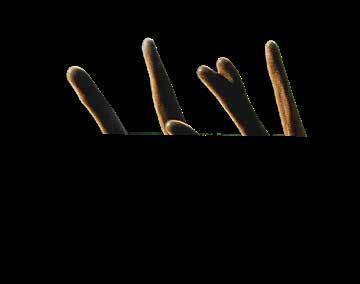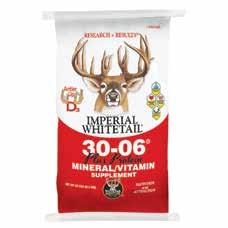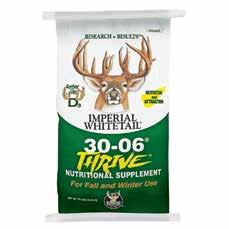
9 minute read
BEST OF CLASS
How to Ensure Your Food Plots are the Best in the Neighborhood BEST OF CLASS

Advertisement

■ by Scott Bestul
PHOTO BY CHARLES J. ALSHEIMER
Ah, the good old days, when my food plots were the only show in town. Deer galloped into them like heifers let out of a pen for the first time in weeks, gleeful to get at the green food I’d planted. And I patted myself on the back for offering whitetails a buffet when they had few other choices.
I knew it would change, of course, and it has. In most of the areas I hunt, other hunter-managers are now doing the same thing I’ve done for years. They’re planting food and making cover for whitetails, and I’ll admit some of them are pretty darn good. In short, deer have choices now they didn’t have only a handful of years ago. It would be tempting — though unproductive — to pine for times when deer were naive and liked me better than anyone else. Instead, I’ve just learned to get better at what I do. Here are a few tips I’ve learned to make sure I’m — to borrow an old Army recruiting phrase — being all that I can be.
Keep the Rotation
Farmers learn quickly that planting the same stuff in the same dirt every year is tempting but usually counterproductive. Plants have nutritional needs, too, and they draw nutrients from the soil to survive. Although some of those nutrients can be replaced through fertilization, there are other considerations. For these and other reasons, it makes sense to rotate your plantings from plot to plot on a consistent basis. Perennials such as Imperial Whitetail Clover, Fusion and Chic Magnet are obvious exceptions, but in my experience, about the only ones. For the annual lineup, plan on switching seed varieties in your plots on an annual basis or at least every other year for best results.
Let’s assume you have four food plots on your property. I like to have one established in a perennial clover or clover/ chicory blend. Two are devoted to annuals; one for post-rut/late season fare, such as Imperial Winter-Greens or Beets & Greens, the other to a mix more attractive to deer earlier in the season (Pure Attraction is my favorite). The last is one I’m prepping to convert to a perennial plot. The possibilities for this plot are pretty broad. If it’s a spot notorious for weed growth, I might hit it hard with Roundup in spring and then plant it with something such as Whitetail Oats Plus early, let deer hit it until the oats head out, and then plow those under and plant it in a perennial like Imperial Whitetail Clover or Fusion that fall.
By using this basic rotation, I keep offering something new or different to deer in a variety of plots each year, with an Imperial Whitetail Clover or Fusion plot serving as the anchor for the system. Obviously, I might have properties with room for more than four plots, but I work the same basic system and multiply it by that basic ratio.
Know Thyself
Let’s face it: There’s the food plotter we want to be, and then there’s reality. We know we should soil test, fertilize and keep ahead of weeds with herbicides and mowing, and when I go into each food plot season, I have stellar plans and great intentions. And then life happens. Some of our busy lifestyle can’t be helped, of course. If you have one child in soccer, another in softball and a job that eats up 50 hours a week, food plots might (make that should) take a back seat to more important stuff.
Which is why it pays to be honest with yourself when devising a food plot plan. If summers are packed with activity and you don’t have time to tend to the care and maintenance of a clover plot, for example, consider planting an annual. I adore clover plots, which offer essential nutrition to deer for much of the year, not to mention an attraction that’s hard to beat; but they require attention in the spring and summer.
Similarly, if you don’t have the equipment needed for A-to-Z food plot planting (tractors or ATVs and the requisite
implements), don’t give up on food plots. With products such as Secret Spot, BowStand and No-Plow, you can construct a kickbutt food plot with minimal effort and almost zero specialty gear. I know this because I’ve done it several times, especially on properties where it was difficult to haul heavy equipment. It’s easy to convince yourself that if you’re not a farmer — or at least a scaled-down version of one — that you’re out of the food plot game, but it’s not true.

Plant with a Purpose
One thing many managers forget as they plant plots is what they plan to offer deer and when they expect them to eat it. The no-brainer answer is, of course, food. But I learned in a hurry you must do better than that. The type of food is critical, as is when you want or expect deer to eat it. All of which can depend on the time of the year and other factors, including cover slope and hunting pressure.
For example, I have a farm with a 30acre south-facing slope, covered with red cedar and burr oak. During the warm months of summer and early fall, that slope is a deer desert. Because of the warm temps and lack of browse, whitetails cannot meet any of their needs in that area, so a plot designed for those times of year is almost pointless. Of course, everything switches when temps take a dive. Suddenly, that deer desert turns into a whitetail oasis, as deer seek out the warmer ambient temps of the southern slope and the thermal cover provided by the dense cedars. So, we plant a winter blend, such as Winter-Greens or other brassica/turnip blends, and deer destroy the plot in the appropriate season.
Conversely, I have an abandoned pasture parcel on one farm that is not close to good cold-weather bedding or security cover. So, I devote plots in this area to early fall offerings, such as clover, Whitetail Oats Plus and other blends, and have had terrific success. Those plots have done more than anything to teach me the importance of studying how deer naturally use the landscape and planning my food plots accordingly.
IMPERIAL WHITETAIL FUSION
• A premium food plot mix of Imperial Clover plus the added benefit of our exclusive WINA Chicory • Perennial — Single planting lasts up to five years • Up to 44% protein
Optimum Growing Environment:
• Soil Type: Moderately drained soils to heavy soils that hold moisture • Soil pH: 6.0-7.5 • Sunlight: 4 to 6 hours of daily sunlight
Don’t Forget Fall
One of the most common traps food plotters fall into is the rush to get things planted in spring and early summer. I know this because I’ve made the same mistake multiple times. In a rush to get plots in as soon as turkey season was finished, my initial optimism often gave way to frustration, as abundant and aggressive weed growth threatened my plot. Of course, there are some wonderful herbicides (Arrest Max and Slay are two of the best) designed to combat this situation, and they work well when applied at the proper time. But because summer is one of my busiest work periods, time crunches often prevented me from jumping on weeds when I should.
Then I discovered the beauty of late summer/early fall planting. With weed germination waning, if not done, competition for space and nutrients let my food plot seed perform as it should, especially with a clover planting. In the past, I’d always wanted to get clover in the ground as early as possible, envisioning a lush clover plot that would attract fall whitetails. What I frequently got instead were clover seedlings struggling to survive among weeds that were off to the races almost as soon as I’d planted. Finally, a farmer/ hunter buddy suggested waiting until August or September.
“Plant your clover with a nurse crop like oats,” he said. “The nurse crop will jump out of the ground immediately and suppress whatever weed competition you might have, and will be attractive to deer, too. Meanwhile, your clover has a great start for next spring, when you really want something green for does ready to drop fawns and bucks starting to grow antlers.”
As is so often true, my farmer friend was correct. Now I plan all my clover plots for fall plantings, and my success in growing killer clover has skyrocketed. I create better clover plots than ever and do so with less maintenance, lower input costs (as in almost no herbicide application) and almost zero frustration. Of course, the same can be said for annual plantings, and I’ve had solid success waiting until late summer to plant offerings such as Beets & Greens, Whitetail Oats Plus, Winter-Greens and others. Whitetail Oats Plus is also ideal for a nurse crop.
Conclusion
Successful food plotting depends far more on common sense than rocket science. By paying attention to what works in your region and how deer behave on your property, you can get better at planting the right seeds in the right places and making your property as attractive to deer as possible. One thing I wish I would have learned a lot earlier in my food plotting experience was a willingness to ask for advice and to get a second set of eyes on my property. So often, a fresh perspective can shed light on situations that trouble us or offer a solution we hadn’t pondered before. Getting the most out of our food plots and how they fit into our management plans is an ever-evolving process — and one I enjoy tweaking every year.


RESEARCH EQUALS RESULTS



WHITETAIL INSTITUTE SUPPLEMENTS
Mineral and vitamin supplementation is vital for maximum antler growth. 30-06 mineral and vitamin supplements are scientifi cally designed and professionally formulated to provide maximum deer nutrition. 30-06 products are also extremely attractive to whitetails.
(30-06 products might be considered bait in some states. Check your local game regulations before using or hunting over 30-06.)






